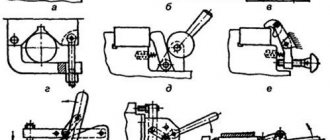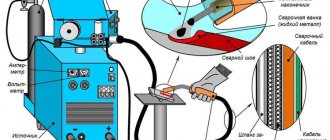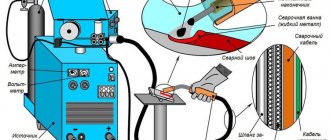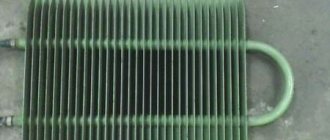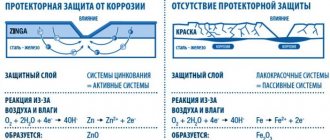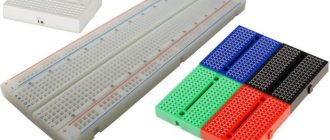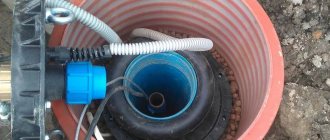Design difference
Technical conditions imply various equipment in the manufacture of cables, but there are basic rules that all manufacturers adhere to. The structure of the cable is not one continuous thread. To assemble it, a certain number of steel wires are used, which are intertwined with each other. The design contains a core around which winding is carried out. The core may not necessarily be metal. In some solutions it does not bear the main load, but provides the shape of the final product. In addition, its function is to maintain roundness under mechanical stress. The core, like other elements, is coated with an anti-corrosion compound based on zinc or aluminum.
In addition to metal cores, cotton cable, film, manila or sisal can be used for cables. Organic materials tend to degrade under the influence of bacteria and putrefactive processes. That is why, for strength, they require treatment with special compounds. They are various lubricants, which also reduce friction of components, which reduces internal stress. It would be wrong not to mention the possibility of using various synthetic threads as a core. Most often they are made of polyamide, which has excellent strength characteristics. A portion of polyamide threads is placed as a separator between the metal components of the cable, which eliminates friction and extends service life. The advantage of such solutions is the reduction in weight of the structure.
Note! The metal cores can be plates or wires, which are also insulated from the other components.
All steel ropes are classified according to their level of flexibility:
- hard;
- medium flexibility;
- increased flexibility.
The main criterion by which such a distinction is made is the quantity and material of the core. In the first version, the core is 42 wires and additional organic components. For medium flexibility, the number of wires in the core is increased to 72, and in flexible ones it reaches 144 pieces, which are divided into 6 separate strands.
How to go?
It’s harder for the towed person to drive. In the film “Morning Detour,” the hero of Andrei Myagkov, whose Moskvich took some kind of truck in tow, tries in vain to stop him, because he simply... forgot about him! Therefore, the tug driver needs to look in the mirror more often: has he lost the poor guy somewhere along the way...
The vehicle being towed must have functioning steering and brakes. Before driving, be sure to unlock the steering wheel.
- If you have any questions about the selection and proper operation of cables, as well as the necessary accessories for them, please contact the Za Rulem online store! According to good tradition, prices for the entire range have been reduced for the period of publication of the article.
5 principles of towing: choosing the right cable
|
|
|
|
|
|
|
|
|
|
|
|
|
|
|
|
|
|
|
|
Table 13
Steel cable type TK in 133 wires with a metal core
(GOST 3067-55)
| Cable diameter, mm | Estimated weight of 100 linear meters of cable, kg | Estimated tensile strength of cable wires, kg/mm 2 | ||||||||
| 120 | 130 | 140 | 150 | 160 | 170 | |||||
| Rope breaking strength, kg | ||||||||||
| 9,0 | 33,35 | 3830 | 4150 | 4470 | 4790 | 5110 | 5430 | |||
| 9.75 | 39.45 | 4540 | 4920 | 5295 | 5675 | 6055 | 6435 | |||
| 10,5 | 45,36 | 5210 | 5650 | 6080 | 6520 | 6960 | 7390 | |||
| 12.0 | 59,27 | 6810 | 7380 | 7950 | 8500 | 9090 | 9640 | |||
| 13,5 | 74,95 | 8620 | 9360 | 10000 | 10 750 | 11450 | 12150 | |||
| 15,0 | 92.50 | 10600 | 11 500 | 12400 | 13300 | 14150 | 15000 | |||
| 16,5 | 111.9 | 12 850 | 13900 | 15000 | 16100 | 17 150 | 18200 | |||
| 18,0 | 133,1 | 15300 | 16550 | 17850 | 19 100 | 20400 | 21650 | |||
| 19,5 | 156,3 | 17950 | 19450 | 20 950 | 22450 | 23950 | 25500 | |||
| 21,0 | 181,4 | 20850 | 22600 | 24350 | 26050 | 27800 | 29550 | |||
| 22,5 | 207.4 | 23800 | 25800 | 27800 | 29800 | 31800 | 33750 | |||
| 24,0 | 236,8 | 27200 | 29500 | 31 750 | 34050 | 35300 | 38550 | |||
| 25,5 | 267,5 | 30750 | 33300 | 35 900 | 38 450 | 41050 | 43600 | |||
| 27,0 | 299,3 | 34400 | 37 300 | 40 150 | 43 050 | 45 900 | 48750 | |||
| 30,0 | 370,0 | 42550 | 46100 | 49650 | 53200 | 56 750 | 60 300 | |||
| 33.0 | 447,7 | 51 500 | 55800 | 60100 | 64400 | 69700 | 73000 | |||
| 36,0 | 532,6 | 61 250 | 65400 | 71 500 | 76600 | 81 700 | 86700 | |||
| 39.0 | 625,7 | 71 950 | 78800 | 84000 | 89650 | 95600 | 102000 | |||
| 42,0 | 724,7 | 83400 | 90100 | 97300 | 104000 | 110500 | 118000 | |||
| 45,0 | 833,1 | 95600 | 103 500 | 111500 | 119500 | 127500 | 135500 | |||
| 48,0 | 947,4 | 109000 | 118000 | 127000 | 136000 | — | — | |||
| 52,5 | 1133.6 | 130500 | 141000 | — | — | — | — | |||
| 57,0 | 1336,3 | 153500 | 166000 | — | — | — | — | |||
| 60,0 | 1481,2 | 164500 | 178000 | — | — | — | — | |||
- Notes.
1) GOST 3067-55 provides for the production of cables with a diameter of 3 mm and
with a design tensile strength of all cables and above 170
kg 1mm2,
namely: 180, 190, 200, 210, 220, 240, 250, 260.
Table 14
Steel cable type LK-0 in 42 wires with an organic core
(GOST 3069-55)
| Cable diameter, mm | Estimated weight of 1 0 linear meters of cable, kg | Estimated tensile strength of cable wires, kg/mm 2 | ||||||||
| 120 | 130 | 140 | 150 | 160 | 170 | |||||
| Rope breaking strength, kg | ||||||||||
| 2,1 | 1,54 | 270 | 242 | |||||||
| 2,3 | 1.83 | — | — | — | 277 | 287 | ||||
| 2,5 | 2,14 | — | 297 | 317 | 337 | |||||
| 2,7 | 2.49 | — | 345 | 368 | 392 | |||||
| 2,9 | 3.05 | — | — | — | 423 | 451 | 479 | |||
| 3,2 | 3.66 | 474 | 508 | 543 | 576 | |||||
| 3.5 | 4,37 | . | 566 | 606 | 646 | 687 | ||||
| 3,8 | 5.09 | 658 | 706 | 752 | 800 | |||||
| 4,7 | 7,91 | 952 | 1030 | 1 090 | 1 160 | 1230 | ||||
| 5.6 | 11,44 | 1260 | 1370 | 1 470 | 1580 | 1690 | 1 790 | |||
| 6,5 | 15,54 | 1720 | 1860 | 2010 | 2150 | 2290 | 2430 | |||
| 7,5 | 20,32 | 2250 | 2430 | 2620 | 2820 | 3000 | 3 190 | |||
| 8,5 | 25,68 | 2840 | 3 080 | 3320 | 3560 | 3800 | 4040 | |||
| 9.5 | 31,70 | 3510 | 3800 | 4100 | 4 390 | 4 690 | 4980 | |||
| 10,5 | 38,36 | 4250 | 4610 | 4960 | 5320 | 5670 | 6030 | |||
| 11,5 | 45,63 | 5060 | 5490 | 5910 | 6320 | 6750 | 7 170 | |||
| 12,5 | 53,58 | 5940 | 6440 | 6940 | 7440 | 7930 | 8420 | |||
| 13.5 | 62,19 | 6900 | 7470 | 8050 | 8630 | 9160 | 9740 | |||
| 14,5 | 71,07 | 7890 | 8550 | 9160 | 9830 | 10500 | 11 150 | |||
| 15,0 | 81,17 | 8980 | 9740 | 10500 | 11250 | 12000 | 12750 | |||
| 36,0 | 91,67 | 10 100 | 10950 | 11 800 | 12700 | 13550 | 14400 | |||
| 17,0 | 102,5 | 11350 | 12300 | 13250 | 14200 | 15150 | 16100 | |||
| 19,0 | 126.8 | 14050 | 15200 | 16400 | 17550 | 18750 | 19900 | |||
| 21 0 | 153,4 | 17000 | 18400 | 19800 | 21 250 | 22650 | 24100 | |||
| 22,5 | 182,5 | 20200 | 21 900 | 23600 | 25300 | 27 000 | 28700 | |||
| 24,5 | 214,4 | 23 800 | 25 750 | 27750 | 29750 | 31700 | 33700 | |||
| 26,5 | 248,3 | 27500 | 29850 | 32150 150 | 34400 | 36750 | 39050 | |||
| 28,0 | 285,5 | 31650 | 34350 | 36 950 | 39600 | 42250 | 44900 | |||
- Notes.
1) GOST 3069-55 provides for the production of cables with a design tensile strength above 170 kg/m2,
namely: a) cables of all specified diameters up to 180 and 190
kg/mm
b) cables with diameters from 2.1 to 2.3
mm
180 190 200, 210, 220. 230, 240, 250 and 260
kg/mm2,
c) cables with a diameter from 2.5 to 2.9
mm
180, 190, 210, 230 and 240
kg/mm2.
See Tables for plant ropes
Further.
Areas of use of steel cable
Currently, towing steel cable is most often in demand in lifting and traction mechanisms (overhead cranes, excavators, drilling rigs). It can also be used in elevator shafts as a lifting mechanism. It is widely used in reinforcing reinforced concrete structures. Due to its high reliability, the rope can withstand enormous loads and is freely used in the process of heavy construction manipulations, for example, for lifting concrete slabs to the height of a nine-story building. Rope slings are made from steel cables - load-handling, strong, flexible devices that are used when loading any large objects.
It is worth noting that when choosing a steel cable for a winch or other mechanisms, you should turn to the opinion of professionals, since among the current variety, a beginner will not be able to choose the right product for himself. Additional elements supplied with cables undergo special tests and must comply with the necessary regulations and certificates. The main working qualities for a rope are flexibility, maximum tension values, strength and load-carrying capacity. Don’t forget about the processing nuances that allow you to extend the life of the cable in an aggressive environment. For some applications, the weight of the steel cable is important, and sometimes this can even become a reason to abandon this device.
What does the marking say?
In addition to the selection factors discussed above, the design of the rope itself must also be considered, which may affect the loads it can withstand. The simplest steel rope design is single lay. It is a core around which the wire is twisted. Such options can be used for towing, but most often they are components of complex structures. For example, for doubles. They also have a core, but two strands are already wound around it, and a certain alternation must be observed. Single strands are used to create steel ropes, which have several layers in their structure. This mechanism makes it possible not only to increase strength, but also to eliminate deformation and twisting of the element under load.
Double lay cables are also the basis of triple lay products. The first ones are also called strands. They may differ in some features from conventional double lay ropes, which makes it possible to give them the required shape. In the manufacture of cables, the concept of linear tangency is used; it is denoted by the abbreviation LC. It is used in complex structures that can have several strands with different lay pitches around the core. If LC is equal to zero, then it is assumed that all strands have the same length and the same area of contact with the core, which is reflected in a uniform pattern.
Not only the strands can be uneven in the design, but also the wire in the strands themselves. If it is of different diameters, then the product will have the designation LK/R. In steel ropes, in which there are several strands, some of which are made of wire of the same diameter, and others of mixed diameters, then a mark is made in the form of the abbreviation LK-RO. Each of the cables where these strands are used has certain characteristics, so some are better suited for towing, while others are better suited for rigging.
For static loads, steel ropes are most often used, which are made using point contact technology. They have strands in their design that can be made not only of wire of different diameters, but also of different winding pitches. In this case, various strands also intersect with each other. The reason for use only for static loads is the high friction of individual components under varying loads. This will eventually damage the product. A subtype of steel ropes are combined ones, which use linear and point touch technology.
Types of steel ropes
Cables are twisted or twisted products made from steel, synthetic and organic threads. In the production of steel products, galvanized high-carbon wire with a cross-section of 0.4–3 mm is used, which has a significant margin of strength under tensile loads (from 130 to 200 kgf/mm 2 ).
The metal threads used in the manufacture of products come in several grades. Wire of category B has the best strength characteristics; raw materials of grades I and II are considered to be of lower quality. Before determining what load a cable of 5 mm or other thickness can withstand, you should take into account that, regardless of the quality of the material, ropes differ in design and come in three types:
- Single lay - made from one strand with wire of the same section. Their elements are twisted around one of the metal threads in up to 4 layers. Steel cables are marked as a sum of numbers indicating the number of wires in the weave. For example, 1+9+9 means that there are 19 wires in the rope, one of which is located in the central part, 9 twists in the first layer and 9 in the second.
- Double lay - made of several strands, applied in 1-2 layers around the core. For the core, twisted wire, organic or mineral materials are used, which improve the strength of the steel cable and prevent strands from falling inside the product. Most often, such products are used for cable work.
- Triple lay - made of several cables. As with double lay, they have a core, but are made from wire of a smaller cross-section and are used where increased flexibility of the ropes is required (usually for cable work).

